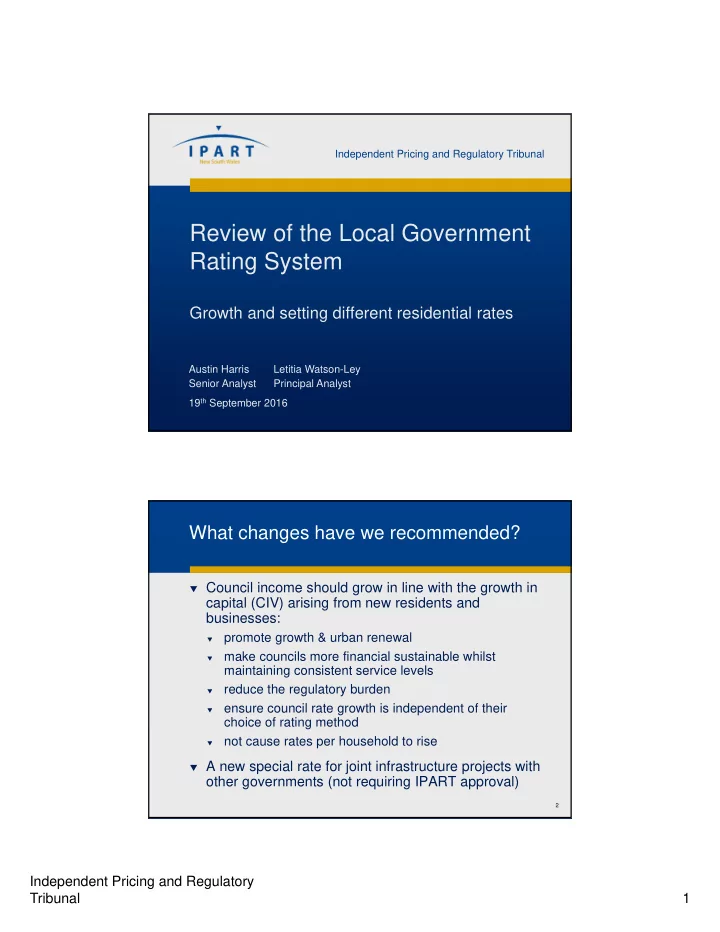

Independent Pricing and Regulatory Tribunal Review of the Local Government Rating System Growth and setting different residential rates Austin Harris Letitia Watson-Ley Senior Analyst Principal Analyst 19 th September 2016 What changes have we recommended? Council income should grow in line with the growth in capital (CIV) arising from new residents and businesses: promote growth & urban renewal make councils more financial sustainable whilst maintaining consistent service levels reduce the regulatory burden ensure council rate growth is independent of their choice of rating method not cause rates per household to rise A new special rate for joint infrastructure projects with other governments (not requiring IPART approval) 2 Independent Pricing and Regulatory Tribunal 1
Why have we made these changes? A metropolitan council’s growth in residential Council rates income under strata subdivision properties and rates income Index Cumulative increase excluding rate peg, 2009-10 = 100 115 Residential properties Real income of council Real income of council w/o SV 110 105 100 95 2009-10 2010-11 2011-12 2012-13 2013-14 2014-15 The current system does not properly compensate councils for growth from new developments Councils have incentives to maximise base or minimum amounts as part of their rate structure 3 How does this change work in practice? Growth ‘outside the rate peg’ should instead be scaled by the percentage change in CIV: ������ ���� � � ������ ���� � � 1 � ���� ��� � 1 � �������� �� ��� Benefits Council income increases in-line with the growth in capital from new developments, approximating their cost growth Reduction in regulatory burden as the number and size of SVs would significantly decrease Councils are not motivated to structure rates with high base or minimum amounts to maximise ‘growth outside the peg’ 4 Independent Pricing and Regulatory Tribunal 2
A new special rate for joint infrastructure Current special rates are of limited use for joint infrastructure projects This recommendation would make it easier for councils to partner with other levels of government to provide new infrastructure This new special rate: would not be included in a council’s general income as it is not funding core council services would not need regulatory approval by IPART 5 Flexibility to set different residential rates Remove ‘centre of population’ requirement Councils can set different residential rates if satisfy criteria • Is the area a separate town or village? Separate town • Criterion reflects existing OLG guidelines or village • Mainly relevant for rural & regional councils OR • Does the area have a different community of Different interest? community of • Differences in access, demand or costs interest • Mainly relevant for metro councils 6 Independent Pricing and Regulatory Tribunal 3
Different community of interest Access, demand or costs criteria Within a contiguous urban development, an area has different: access to OR council services and demand for infrastructure OR costs of providing compared to other areas in that development 7 Different community of interest Tailor rates to local circumstances Example of how • Growth area councils could use • Greater Area A different rates to: access to new Area C infrastructure Respond to local Area B • Existing circumstances suburbs • No differences Minimise any • Development in access, cross-subsidies with private demand or between areas costs across facilities these suburbs • Lower demand Provide incentives for services for development 8 Independent Pricing and Regulatory Tribunal 4
Different community of interest Protections to promote equity and transparency Difference between highest & lowest rate structure limited to 1.5 times otherwise obtain approval from IPART ad valorem rate 1.5 times difference between AND highest & lowest base amount Transparency requirements Publish details of different rates (plus reasons for them) Website & rates notice 9 New councils after the rate path freeze Establishing new rate structures If a new council can it should be able to choose identify… to... gradually equalise rates across pre-merger areas OR separate towns or villages keep existing rate structures in pre-merger OR Requires areas different IPART approval if communities of OR exceed 1.5 interest times limit move to a different rate structure 10 Independent Pricing and Regulatory Tribunal 5
New councils after the rate path freeze Gradual equalisation of rates If a new council is required to equalise rates across pre-merger areas (or chooses to) should be a gradual process Maximum of 10 percentage points Set limit on rate increase • above rate peg or applicable SV from equalisation • each year Limit acts as a ceiling New councils can go Allows councils to take into account below this limit ratepayers’ ability to pay 11 Questions for consideration Do you agree with the use of CIV as the basis for determining growth outside the peg, irrespective of the valuation method used for levying rates? What are your views on the proposed criteria for setting different residential rates? Separate town or village . Different community of interest. Do you agree with the maximum difference (1.5 times) between highest and lowest rate structures without need for regulatory approval? What are your views on setting a maximum limit for rate increases arising from equalisation for new councils? 12 Independent Pricing and Regulatory Tribunal 6
Independent Pricing and Regulatory Tribunal www.ipart.nsw.gov.au Independent Pricing and Regulatory Tribunal 7
Recommend
More recommend